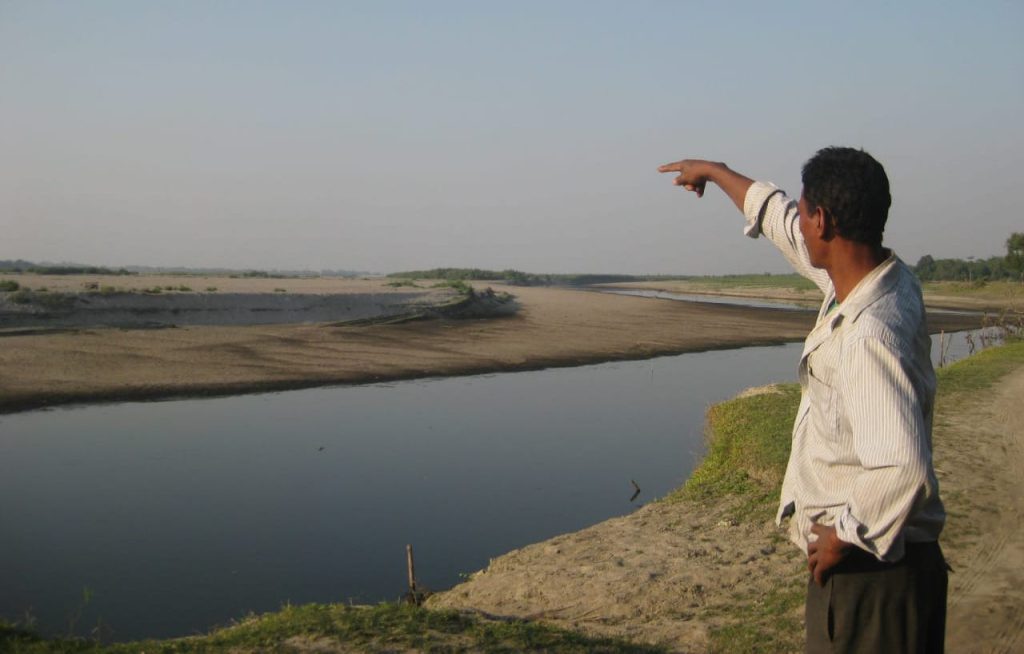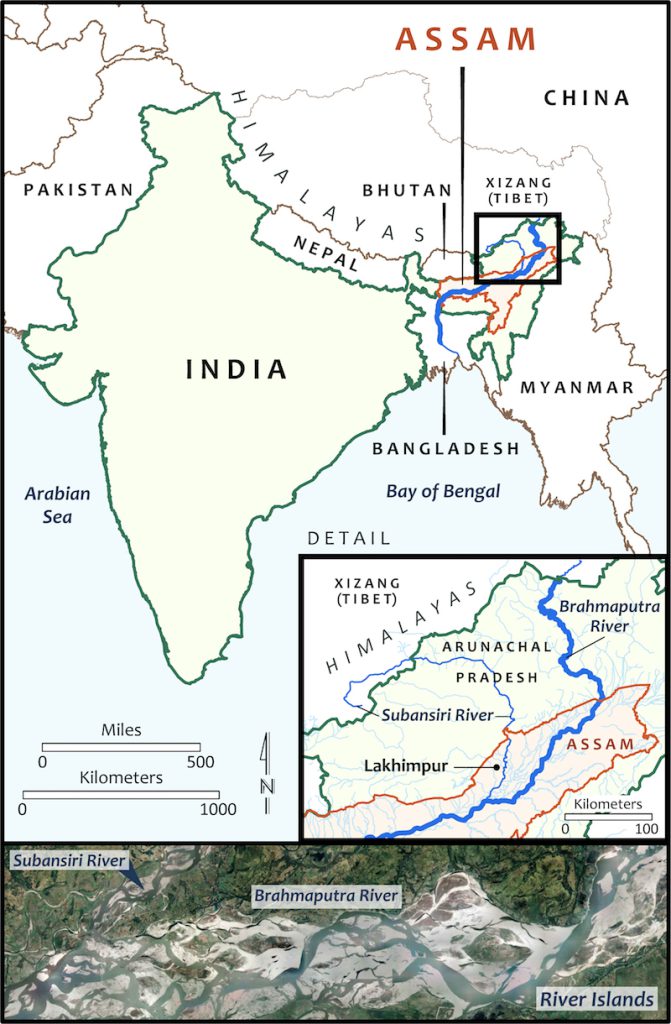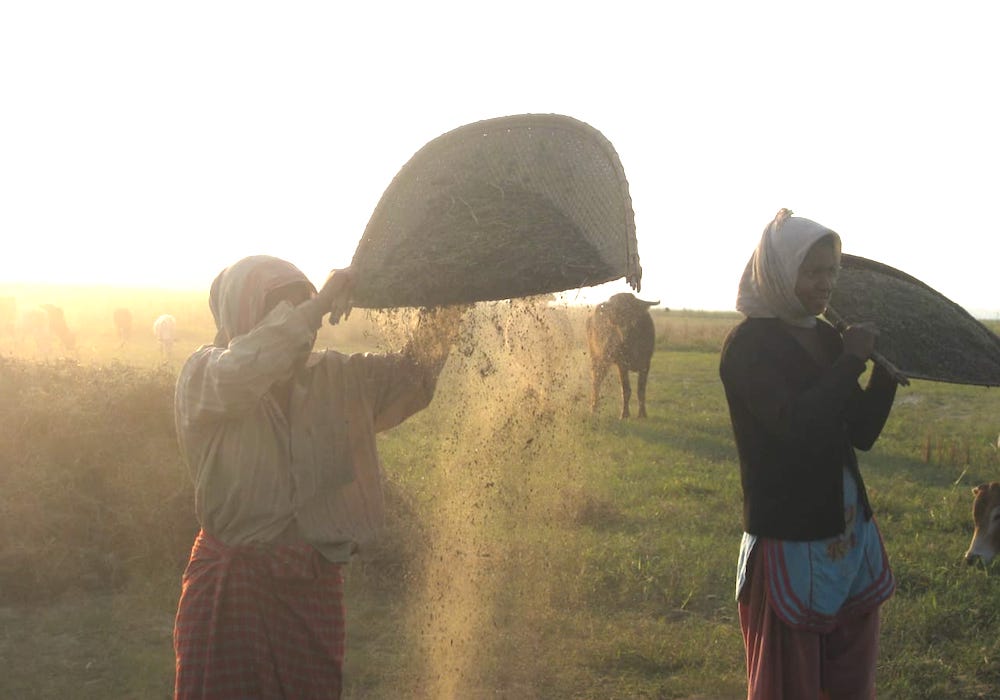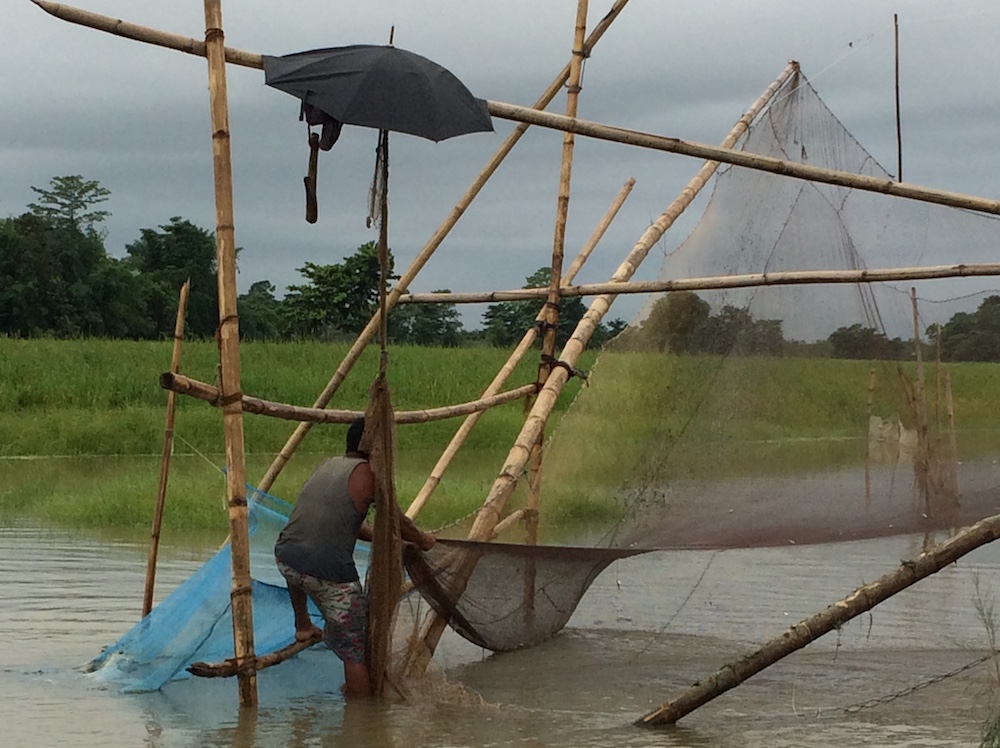The Struggles of a “River People” in Assam

One night when we were making dinner, I asked Jeuti (a pseudonym), “What is the meaning of the word Mising?” As we smoked fish over a fire, the light flickered across the cane walls of her home.
“Mising means man (mi) of the water (asi),” Jeuti replied as she blew into the fire. She held her saador, a shawl-like garment, away from the flames. Stray hairs flew from the middle-aged woman’s tightly coiled bun.
Jeuti, her immediate family, and her extended kin live in a house built on bamboo stilts (a saang ghor, in Assamese) on a char, a semi-stable river island, on the Brahmaputra River in the Northeast state of Assam in India. They are part of the Mising community, which identifies itself as “Indigenous” (bhumiputra) and “tribal” (janajati).
Historically, the Mising, a community of around 700,000 people, have inhabited areas close to the Brahmaputra, earning them the label of “river people” by those who live on the mainland. Outsiders see the river as an unpredictable force—one that constantly brings in silt, disrupting the lives of the people who make their homes near it. The Mising, accordingly, are often portrayed by outsiders as people isolated from the rest of “civilization,” living temporary, fluid existences.
The Mising people I met when I first came to this area a few years ago, such as Jeuti, also used the term “river people” to describe their community. But to them, it meant something different. It pointed to how the river had guided their community’s migrations over the centuries and remained integral to their identities.
The Mising have adopted some religious and lifestyle practices of the majority Assamese Hindu population over the centuries since their waves of migration from the eastern Himalayan mountains to the plains of the Brahmaputra River Valley around the 13th or 14th century. However, in many ways the Mising remain rooted in distinct ways of life connected to other cultural groups living along the Brahmaputra River in the hilly regions of the adjacent Indian state of Arunachal Pradesh and the mountains of Tibet.
Since the 1950s, the Mising have been fighting for political recognition, land allocations, and cultural and linguistic freedom as part of a broader tribal autonomy movement in Assam. The Mising involved in this movement assert that their belonging in Assam has connections to cultures and regions woven together by the Brahmaputra River and its tributaries, which cut across contemporary postcolonial state boundaries in India.
The Mising’s way of life and identity increasingly face threats from several directions: conservative political movements led by Hindu nationalists who attempt to categorize them as either Hindu or tribal, the destructive effects of climate change, and state-led development projects such as dams that disrupt the river’s flow while generating energy for people outside of the community.
When I started conducting research for my doctorate in anthropology in the char region, I came to realize that if I wanted to understand what it meant to be Mising, then I needed to understand what the river meant to this community.
The state of Assam, where Jeuti’s family lives, has a population of about 36 million people. In the 2011 census, 62 percent of the population was counted as Hindu, 34 percent as Muslim, 4 percent as Christian, and less than 1 percent as Sikh, Buddhist, Jain, and other religions. About 12 percent of the population in Assam are also members of Scheduled Tribes, the term used in the Constitution of India to demarcate tribal communities and accord them socioeconomic protections in employment and education, similar to affirmative action measures elsewhere.
The question of who counts as tribal and/or Indigenous—and who deserves the rights of citizenship—has long been a contentious one in India, where diverse linguistic, religious, and cultural traditions reflect complicated histories of migration, colonization, and displacement.
In many parts of the world, European colonial categorizations of “Natives” and “tribes” coded Indigenous communities as being biologically and socioeconomically inferior to colonizers. In India, British colonizers often built on precolonial Hindu caste hierarchies and assumed tribal populations to be isolated groups living in “primitive” conditions.
Moreover, British colonial administrators understood tribes through imperial race science, a pseudoscientific set of beliefs that justified racial hierarchies and mapped race categories onto people’s physical attributes and geographic locations. In Assam, these distinctions were based on specific facial traits that communities in what is now Northeast India were seen to share with neighboring Asian countries such as China and Tibet. These categorizations also distinguished between the “plains tribes” that lived in the flat, lowland areas of the Brahmaputra River Valley and the “hill tribes” that lived higher up in the mountains.
As a result, several migratory communities in Assam were forced to identify as either plains or hill tribes. In reality, they often claimed belonging to both of those landscapes.
With the 19th-century discovery that the Brahmaputra River Valley’s soil fertility was suitable for tea cultivation, colonial administrators made further distinctions between plains and hill tribes. Plains communities were put to work managing and providing labor to lucrative tea plantations and other agricultural ventures, while hill communities were seen as less economically significant. In 1944, British colonial administrator Robert Reid summed up these assumptions about tribal differences in Assam, writing of hill communities: “Neither racially, historically, culturally, nor linguistically have they any affinity with the people of the plains or with the people of India proper.”
These invented distinctions were further solidified in the decades following independence in 1947, when states in Northeast India were carved out without regard to the multiple identities that mattered to communities who identified as tribal and/or Indigenous.
This history has shaped the Mising deeply. Though they are today categorized as a Scheduled Tribe of Assam and often seen by outsiders as a plains community, in their lived experiences, Mising people’s understandings of tribe and Indigenousness cross this binary of hills and plains—like the river itself. In doing so, the Mising emphasize cultural and religious similarities with present-day tribal communities in the hills of Arunachal Pradesh while asserting their need for tribal autonomy in Assam.
In recent years, with Hindu nationalism gaining ground in national and local politics in India, questions over citizenship and belonging have grown more contentious. That’s because Hindu nationalists tend to equate being Indigenous to India with being part of the Hindu religious majority. This simplistic framing excludes many other groups in India’s pluralistic society, including the Mising, who make claims of Indigenousness based on different place-based notions of belonging.
The long history of marginalization faced by the Mising and other peoples in the Northeast has come to the forefront again recently because of the Citizenship Amendment Act (CAA), which was passed in 2019 by Prime Minister Narendra Modi and his ruling Bharatiya Janata Party government. The amendment provides all individuals from minority religious communities in Muslim-majority countries the right to claim citizenship in India except for Muslim migrants, a move that is in line with Hindu nationalist thinking.
To be Mising is to be made and unmade by the river.
After the CAA was passed, protests erupted across India. Protestors challenged the way the act framed India as a Hindu homeland—particularly the assumption that citizenship should be grounded on religion.
Although the CAA did not specifically target the Mising, community members are apprehensive that the act signals a political trend toward increasing Hinduization. And tribal communities also know that their marginalization by the Indian state goes beyond religion and extends to historical constructions of tribes as racial “Others.”
The Mising community does receive some government protections; it is already listed as a Scheduled Tribe and has a Mising Autonomous Council. But the Mising have been unsuccessful so far in receiving the more protective Sixth Schedule status—a constitutional provision that helps tribal communities access resources while ensuring protections for their distinctive cultural practices.
Mising community members worry that their increasingly difficult lives on the chars and their demands for Sixth Schedule status will continue to be overlooked by the state.
Although I grew up in Assam, the everyday uncertainties faced by the Mising people living on the chars were far from my own childhood, most of which I spent living in a boarding school in Southern India. Unlike Jeuti’s family, my upper-caste Hindu family remained at a safe distance from the fluctuations of the Brahmaputra River. (The news of flooding in Assam was seldom even covered by national media outlets, though I sometimes received reports during monthly calls from my parents.)
My close encounters with the river began when I started fieldwork. I lived in Jeuti’s home, which she shared with her husband (a former headmaster at the local school), one of her adult daughters, and her eldest son’s family.
After returning from working in the fields at the river’s edge, Jeuti’s extended family members would gather at her house to talk, eat smoked meat, and drink apong, a beverage made from fermented rice. From these conversations, I started to understand that to be Mising is to be made and unmade by the river.
As Jeuti’s son told me: “The river breaks (bhange) and makes (bonay).”
The chars where Jeuti’s family live form in areas where the river’s channel decreases in width; the silt from floodwaters accumulates in these spots, forming heavy deposits of sediments. During the monsoon months of June and July, some of these chars become submerged while others emerge anew. These cyclical patterns—made more unpredictable due to climate change—determine everyday life and food availability in this agricultural community. Often, communities have to migrate seasonally when the monsoon floodwaters wash away their chars.
Jeuti’s char is relatively permanent and located in the Lakhimpur District. It was formed from silt carried by the floodwaters of the Subansiri River, a northern bank tributary of the Brahmaputra. The community has a population of around 1,400 people, according to the last census in 2011.
People from this community often travel to adjacent towns for work, to buy groceries, or to meet other family members. When flooding is at its peak, they have to travel about 10 kilometers by foot, then take a ferry for about two hours one way to reach the nearest town.
When the floodwaters arrive, homes on the chars can be swept away entirely.
In recent years, projects to engineer the Brahmaputra and its tributaries in the Greater Himalayan region for development purposes have further intensified the risks of flooding. Since the early 2000s, Mising and other riverine communities have been protesting the construction of the Lower Subansiri hydropower project, which they claim could increase flash flooding and further disrupt downstream areas in the region of Lakhimpur.
Recently, author Juwel Pegu, a member of the Mising literary association called the Mising Agom Kebang, expressed to me why the struggles faced by Mising people today are different from those faced in the past: “We always lived by the river and felt the floods. But it also gave us food and a life that could sustain the crops our ancestors grew. Now the river gives less and less, floods more, has more sand deposits that bury crops. Plants have disappeared. Pigs, hens, and ducks have become difficult to rear.”
He continued: “Moreover, with rising government initiatives that tell us to follow North Indian ideas of Hinduism that we cannot relate to, our culture is at risk.”
Interwoven into the Mising’s story of cultural resilience is a story of environmental change. Many of these changes have been driven by state-led interventions to shape the river and the lives intertwined with it. These state interventions rarely align with the desires and assertions of local communities.
The Mising community members I know agree that what’s needed is a systematic governmental and legislative plan that grants their community the autonomy and resources to thrive in precarious river environments. This would mean acknowledging how the Mising themselves define tribe, Indigenousness, and belonging—not as constrictive categories but as things that shift and change with the river’s flows.




































